25000 TAGS
NONO
Location: Long March Space, Beijing (formerly known as 25000 Cultural Transmission Center)
Duration: Apr 22 – Jun 17 2007
Artists: Chu Yun, He An, Jiang Zhi, Kan Xuan, Liu Wei, Shi Qing, Colin Chinnery, Wang Wei, Xu Zhen, Yang Zhenzhong, Zhu Yu

Is NONO a double refusal and rejection, or is it the rejection of refusal? Is it saying no, or not saying no? Perhaps the phrase accurately presents the current contradiction in contemporary art, where minor issues are over done, and major issues over looked. The exhibition, curatorless and themeless, is nonetheless linked with each artist’s personal perspective and their attitude towards the contemporary. In a period accustomed to the enfeebled discourse of the curator, is the lack of a curator an inadequacy or another sign of curatorial impotence? In comparison to curators without action, the act of refusing a curator is a direct and raw reality and experiment. The artist’s have done it all DIY, the exhibition itself is spontaneous, autonomous and naturally occurring exchange of experiences, as well as a collective game. There is a consensus among the artists, one that is premised upon the ability to amuse one another. One can conflate it to a metaphysical artistic ideal, or a mundane and profane experience. This is an emerging reality, the self referential packaging of artistic intelligence, and an artistic sincerity restricted by its own freedom. Is there an illusion of swampy marshes from which contemporary Chinese artists must rescue themselves? Is a “bottle neck” among art and artists a hypothetical exercise, or a sign of imminent disaster? To what degree can an artist’s social idealism incite response? Can the work be engaging, or will it merely exist as the artist’s self-delusion? Do these conflicting realities point at a deficiency in the practice of contemporary art, or in the artists themselves? The eleven artists in this exhibition are the leading young artists in the contemporary Chinese art world including the two leading forces in Shanghai, Xu Zhen and Yang Zhenzhong, two Guangdong artists Chu Yun and Jiang Zhi, and the mainstays of Beijing art, Liu Wei, Shi Qing, Colin Chinnery, Wang Wei, Zhu Yu, and He An, and finally female artist Kan Xuan. All of them are showing newly commissioned work. Xu Zhen’s latest effort follows a line of his recent large-scale installations, large not only in size, but also in its concept and possibilities of interpretation – a good example for the exhibition’s ambitious scale.
Covering the entire 1500 square meters of the Long March Space, as well as a specially constructed building in the Long March Space courtyard, it is one of the most anticipated experimental exhibitions to open in Beijing in many years. The exhibition opens in April and will run for three months. The participating artists have kept a low profile leading up to this exhibition, with few photos or written words related to the works. Perhaps, this kind of experience is a necessary requirement for creativity, yet with regards to the public and the media, this kind of reserved attitude has secured an air of mystery. Perhaps this is also one of the intended characteristics of “NONO.”
Chu Yun
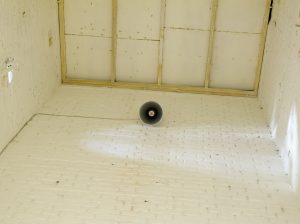
Chu Yun, “Audiotape 1984” , 2006 (courtesy Vitamin Creative Space)
This sound installation is derived from an audiotape recording of a memorized speech given by the artist in 1984 at the age of 8. In the speech, a young Chu Yun exhorts his classmates to learn from and model the heroic actions of a Chinese war hero. Cleanly presented in a renovated old freight elevator shaft within the industrial complex of Factory 798, the installation is composed of a simple bullhorn suspended high upon the shaft walls, which continuously emits the pitched voice of an excited and passionate youth.
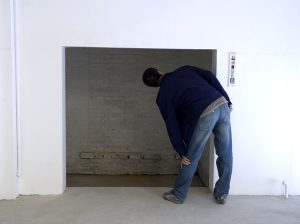
Chu Yun, Career, 2004-2006 (courtesy Vitamin Creative Space)
This work is composed of a set of 27 original images documenting the life of one Chinese government official. The photographs mainly show the official making appearances at various cultural functions and ceremonies, as well as a few photographs taken for personal keepsakes. These beguilingly simple images reveal the artist’s attitude and thinking towards the relationship between individual and social identity, and daily life.
He An
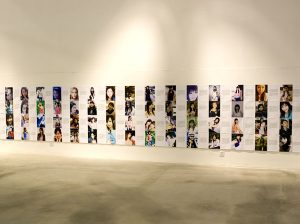
He An, Using the Cheapest Method to Love Your Soul 2, 2007
The works of artist He An have continually revolved around the topics of violence and sex – this work is a continuation of that trend. On 100 pages of A4 inkjet paper, the artist has printed the portraits of 100 “beautiful” women and juxtaposed next to each image the results the artist gathered from three professional Chinese fortune-tellers regarding the possible relationship that these each woman would have with the artist – the work seems almost like the results of a laboratory test, with the subject (images of young women from various backgrounds) combined with a small blot textual diagnosis. Using such a brash and shameless method, the artist examines the economies of beauty and femininity. Worth noting is that most of the images are downloaded from online, with a few images being photographed by the artist himself.
Jiang Zhi
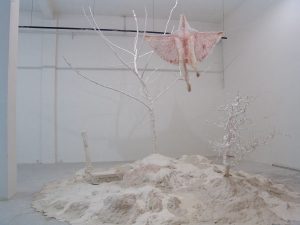
Jiang Zhi, I am Your Poetry No. 4, 2007
The work can best be described as, what seems like a human skin is stretched across a white washed scene. The inspiration for this work is said to have come from a deep visual experience the artist had in his youth while visiting a temple in Tibet. In the fourth installment of this work, the background is an abandoned garden. Two trees, and some discarded items, as well as what appears to be a human skin, transparent and scattered with the traces of capillaries in flight. Beneath a tree, beside a discarded suitcase lies a female figure, spread open and facing towards the sky. The two humanoid figures appear to be some type of organism, or the remains of some unknown life form? Through inducing self-imagination, the artist tries to establish a relationship between the ‘non-human’ and us. It implies our kin with unknown life forms, who very possibly may be the selves discarded by ourselves. The skins full of capillary vessels are exposed in the air, endowing the body and other fragments with delicacy, sensitivity and cruelty, like poetry.
Kan Xuan
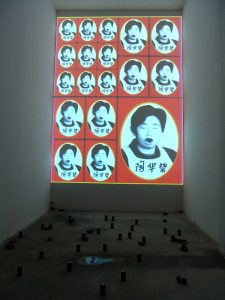
Kan Xuan, China Brand Series 8 – Entering Africa, 2007
The work is composed of two linked parts, the first segment uses the famous figure of “Laoganma” the well renowned “Spokeswoman” of a Chinese hot sauce brand, and shows her various expressions and reactions as if she had eaten something “spicy.” In the second segment the image turns to wildlife in Africa, with several segments of various animals set to a fast beat sound track. Sound is a vital component of the work – from the sounds emitted by “Laoganma” as if she had just tasted the pepper sauce, and the strong beats of African rhythm – imbuing the work with a tribal feel, as well as a humor and free spirit. “Laoganma” is a Chinese brand that is heavily exported to Africa. This relationship serves as inspiration for this work, with the artist using a very individual method to examine and understand the various relationships behind this phenomenon and reality.
Kan Xuan, Liang Yuan! Liang Yuan!, 2007
An image of two silver coins in the equivalent of two Chinese yuan affixed with tape to a variety of small products flashes across the monitor, on cue a hawkers voice continuously hollers out, “Liang Yuan! Liang Yuan!” This work by artist Kan Xuan is simple and direct, light and humorous. The continual flash between the image of the products and the hollering sound creates a monotonous rhythm, which, in a society already accustomed to a market economy, is something that is both familiar, and even something we find comforting and quaint.
Liu Wei
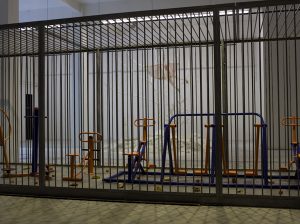
Liu Wei, A Lifestyle, 2007
Encompassed within a giant iron cage with food items scattered around them are a series of exercise equipment commonly found in public parks in local communities or along the roadside. In comparison to the artist’s previous series of works that focused on nature and technology, this work is closely linked with everyday life. The curved shapes of the metal exercise equipment in the center of the installation, and their orange and blue coloring, contrast with the perfectly vertical steel lines of the cage façade. Overall, the work provides a visual impression of solidness and power. The title, “A Lifestyle,” already says it all. This work follows a series of recent works by the artist that examines topsy-turvy results of the theatrical nature of the interior and exterior of living spaces.
Shi Qing
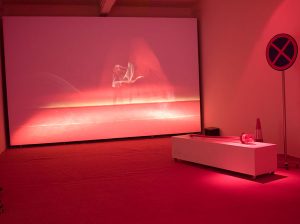
Shi Qing, New Ruse of the Empty City, 2007
The New Ruse of Empty City replicates the original story plot and conducts the original opera sound tracks but changing the context from military battle to traffic control issues during the summit. The play describes the traffic control strategies that are carried out by traffic control department. Beijing as a city for governmental administration and central region of China has serious traffic issues. Those traffic issues are also one of the most sensitive issues for big cities, especially for the capitol Beijing. Having local and international conferences and summits frequently held in the city has given the traffic control department opportunities to carry out their daily practices and operations with drivers in the city. In highly surveillanced controlled traffic systems, those drivers who are breaching traffic regulations are the main targets of the traffic control department and also will be punished within the existing system through self-exile and self-quarantine. This type of city individualism and self-banishment as Michel Foucault describes, “it is a type of power, a modality for its exercise, comprising a whole set of instruments, techniques, procedures, levels of application, targets; it is a ‘physics’ or an ‘anatomy’ of power, a technology.”
Colin Chimney

Colin Chimney, Unicorn, 2007
For this exhibition, Colin Chinnery has traded in his status as a well recognized curator, instead taking part as an artist. The process of creating a work for him, is perhaps more dialectical than for most artists. This series of works in the shape of snails is not very large, 5 different sculptures show different stages of transformation – the snail’s shell slowly rises erect as the snail progresses forward, to finally end in a completely straight tip horn – like that of a unicorn. From the surface, the title seems to refer form and shape of the snail’s shell, but this gradually process of stiffening and straightening easily creates thoughts of an erection – uncovering the different contradictions and tensions as one goes from going from being the weak to the strong.
Wang Wei
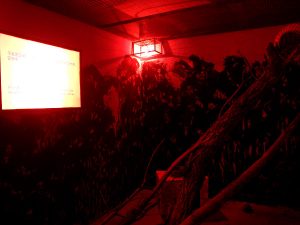
Wang Wei, There are No Nocturnal Animals Here, 2007
The work is composed of 4 separate but linked rooms, simulating a nocturnal animal “house” in a zoo. Within each room there are sloping tree trunks, vegetation, nests, and feeding cages, as well as lightboxes which indicate what region the animals that inhabit the space are from, but the work is clearly titled, “There are No Nocturnal Animals Here.” Nonetheless, those who venture into the dark maze still bring with them a certain preparation, just in case an unspecified animal does come out from somewhere within the dark rooms. This type of curiosity of the unknown, compounded with a suspense and tension, is perhaps the success of the work. One falls into the trap of an imagined identity. Here, there is a reversal of observing and being observed, subjectivity is strengthened through the pushing and prodding of objectivity.
Xu Zhen
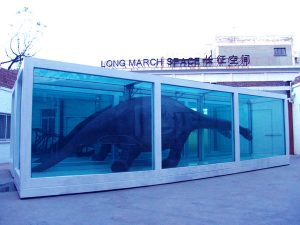
Xu Zhen, Untitled, 2007
In alignment with his previous works, Xu Zhen’s work can be considered “big”. This not only applies to the form of the piece itself, but also to the extensive possibilities it opens up? With obvious references to the British artist Damien Hirst, Xu Zhen deliberately and openly imitates. Is it tribute or mockery? Perhaps such a superficial surmise creates a trap within itself? The work’s strong visual impact in fact says everything. From the outside, the visual display is an exact replica – the glass tank with white framework that contains the dissected animal and the formalin solution in which the animal corpse is immersed. But here, what lies divided within the two tanks is no ordinary animal, but a bulky, beastly, prehistoric brontosaurs.
*The skin is manufactured from a highly lifelike fiberglass resin, the viscera taken from a real animal body, and the two tanks in which it is immersed, are over ten meters long and over three meters high.
Yang Zhenzhong

Yang Zhenzhong, Sleepwalking is a Therapy III, 2006-2007
The film is a shot of hyperrealism injected into a realistic frame. The video is composed of different shots of urban landscape as they are accessed through the traversing of a tunnel. All shots are filmed from the first person, moving and swaying throughout. The perspective should be that of a human, at the same time, it does not feel that way, instead feeling almost like a disembodied spirit floating about absently, unseen, unheard, and unnoticed. Following this camera lens, the audience is taken through a variety of smaller alleys, large streets, chaotic restaurants; flying over the city space for an aerial view, sweeping across a river or an empty lot, and then slipping into the recess of a pipe, a drain, a hole in the wall, and sometimes even a human orifice, and after a few quick gasps to catch one’s breath, heading off again. It seems that the artist is enamored with the urban geography. The technique is that of feeling and experiencing, both sensitive, as well as full of hallucinatory.
Yang Zhenzhong, Na Xiong Na Er, 2007
The ever-rising population of skyscrapers in the city provokes the question of their relationship with the sky that remains forever distant and hovering above. Perhaps there are several answers. The one that Yang Zhenzhong proposes posits the differently shaped buildings as a penis, with the sky as the female counterpart. The rest of the work goes without saying – the building moving up and down in the air, simulating the process of intercourse, all put to a sound track of “shouts” and “murmurs” pulled from erotic movies. This type of extreme juxtaposition, displays the artists humor and wit, at the same time addressing a serious issue.
Zhu Yu
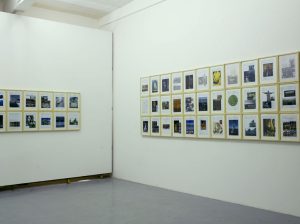
Zhu Yu, Artistic Proposals for the 192 Member Nations of the UN, 2006-2007
Zhu Yu has created a work of considerable scale using images in the form of documents. The proposed art projects are highly tailored the individual characteristics of each of the 192 UN member countries. Each proposal is composed of notes and synthetic images, and highly comprehensible. Some of these proposals have possibility of being realized, while the implementation of others is almost completely impractical. However, the piece fully embodies this artist’s creative and vigorous approach to conceptual art. Who else could so effortlessly produce 192 ingenious proposals? In looking at the content, these proposals are primarily concerned with geopolitics, economics, religion, ethnicity, and other overarching academic themes. From an artistic point of view, the proposals are actually quite easy to understand, even for those audiences that are unfamiliar with the solemn topics; there still remains for all a feeling of simple creative excitement.

Is NONO a double refusal and rejection, or is it the rejection of refusal? Is it saying no, or not saying no? Perhaps the phrase accurately presents the current contradiction in contemporary art, where minor issues are over done, and major issues over looked. The exhibition, curatorless and themeless, is nonetheless linked with each artist’s personal perspective and their attitude towards the contemporary. In a period accustomed to the enfeebled discourse of the curator, is the lack of a curator an inadequacy or another sign of curatorial impotence? In comparison to curators without action, the act of refusing a curator is a direct and raw reality and experiment. The artist’s have done it all DIY, the exhibition itself is spontaneous, autonomous and naturally occurring exchange of experiences, as well as a collective game. There is a consensus among the artists, one that is premised upon the ability to amuse one another. One can conflate it to a metaphysical artistic ideal, or a mundane and profane experience. This is an emerging reality, the self referential packaging of artistic intelligence, and an artistic sincerity restricted by its own freedom. Is there an illusion of swampy marshes from which contemporary Chinese artists must rescue themselves? Is a “bottle neck” among art and artists a hypothetical exercise, or a sign of imminent disaster? To what degree can an artist’s social idealism incite response? Can the work be engaging, or will it merely exist as the artist’s self-delusion? Do these conflicting realities point at a deficiency in the practice of contemporary art, or in the artists themselves? The eleven artists in this exhibition are the leading young artists in the contemporary Chinese art world including the two leading forces in Shanghai, Xu Zhen and Yang Zhenzhong, two Guangdong artists Chu Yun and Jiang Zhi, and the mainstays of Beijing art, Liu Wei, Shi Qing, Colin Chinnery, Wang Wei, Zhu Yu, and He An, and finally female artist Kan Xuan. All of them are showing newly commissioned work. Xu Zhen’s latest effort follows a line of his recent large-scale installations, large not only in size, but also in its concept and possibilities of interpretation – a good example for the exhibition’s ambitious scale.
Covering the entire 1500 square meters of the Long March Space, as well as a specially constructed building in the Long March Space courtyard, it is one of the most anticipated experimental exhibitions to open in Beijing in many years. The exhibition opens in April and will run for three months. The participating artists have kept a low profile leading up to this exhibition, with few photos or written words related to the works. Perhaps, this kind of experience is a necessary requirement for creativity, yet with regards to the public and the media, this kind of reserved attitude has secured an air of mystery. Perhaps this is also one of the intended characteristics of “NONO.”
Chu Yun

Chu Yun, “Audiotape 1984” , 2006 (courtesy Vitamin Creative Space)
This sound installation is derived from an audiotape recording of a memorized speech given by the artist in 1984 at the age of 8. In the speech, a young Chu Yun exhorts his classmates to learn from and model the heroic actions of a Chinese war hero. Cleanly presented in a renovated old freight elevator shaft within the industrial complex of Factory 798, the installation is composed of a simple bullhorn suspended high upon the shaft walls, which continuously emits the pitched voice of an excited and passionate youth.

Chu Yun, Career, 2004-2006 (courtesy Vitamin Creative Space)
This work is composed of a set of 27 original images documenting the life of one Chinese government official. The photographs mainly show the official making appearances at various cultural functions and ceremonies, as well as a few photographs taken for personal keepsakes. These beguilingly simple images reveal the artist’s attitude and thinking towards the relationship between individual and social identity, and daily life.
He An

He An, Using the Cheapest Method to Love Your Soul 2, 2007
The works of artist He An have continually revolved around the topics of violence and sex – this work is a continuation of that trend. On 100 pages of A4 inkjet paper, the artist has printed the portraits of 100 “beautiful” women and juxtaposed next to each image the results the artist gathered from three professional Chinese fortune-tellers regarding the possible relationship that these each woman would have with the artist – the work seems almost like the results of a laboratory test, with the subject (images of young women from various backgrounds) combined with a small blot textual diagnosis. Using such a brash and shameless method, the artist examines the economies of beauty and femininity. Worth noting is that most of the images are downloaded from online, with a few images being photographed by the artist himself.
Jiang Zhi

Jiang Zhi, I am Your Poetry No. 4, 2007
The work can best be described as, what seems like a human skin is stretched across a white washed scene. The inspiration for this work is said to have come from a deep visual experience the artist had in his youth while visiting a temple in Tibet. In the fourth installment of this work, the background is an abandoned garden. Two trees, and some discarded items, as well as what appears to be a human skin, transparent and scattered with the traces of capillaries in flight. Beneath a tree, beside a discarded suitcase lies a female figure, spread open and facing towards the sky. The two humanoid figures appear to be some type of organism, or the remains of some unknown life form? Through inducing self-imagination, the artist tries to establish a relationship between the ‘non-human’ and us. It implies our kin with unknown life forms, who very possibly may be the selves discarded by ourselves. The skins full of capillary vessels are exposed in the air, endowing the body and other fragments with delicacy, sensitivity and cruelty, like poetry.
Kan Xuan

Kan Xuan, China Brand Series 8 – Entering Africa, 2007
The work is composed of two linked parts, the first segment uses the famous figure of “Laoganma” the well renowned “Spokeswoman” of a Chinese hot sauce brand, and shows her various expressions and reactions as if she had eaten something “spicy.” In the second segment the image turns to wildlife in Africa, with several segments of various animals set to a fast beat sound track. Sound is a vital component of the work – from the sounds emitted by “Laoganma” as if she had just tasted the pepper sauce, and the strong beats of African rhythm – imbuing the work with a tribal feel, as well as a humor and free spirit. “Laoganma” is a Chinese brand that is heavily exported to Africa. This relationship serves as inspiration for this work, with the artist using a very individual method to examine and understand the various relationships behind this phenomenon and reality.
Kan Xuan, Liang Yuan! Liang Yuan!, 2007
An image of two silver coins in the equivalent of two Chinese yuan affixed with tape to a variety of small products flashes across the monitor, on cue a hawkers voice continuously hollers out, “Liang Yuan! Liang Yuan!” This work by artist Kan Xuan is simple and direct, light and humorous. The continual flash between the image of the products and the hollering sound creates a monotonous rhythm, which, in a society already accustomed to a market economy, is something that is both familiar, and even something we find comforting and quaint.
Liu Wei

Liu Wei, A Lifestyle, 2007
Encompassed within a giant iron cage with food items scattered around them are a series of exercise equipment commonly found in public parks in local communities or along the roadside. In comparison to the artist’s previous series of works that focused on nature and technology, this work is closely linked with everyday life. The curved shapes of the metal exercise equipment in the center of the installation, and their orange and blue coloring, contrast with the perfectly vertical steel lines of the cage façade. Overall, the work provides a visual impression of solidness and power. The title, “A Lifestyle,” already says it all. This work follows a series of recent works by the artist that examines topsy-turvy results of the theatrical nature of the interior and exterior of living spaces.
Shi Qing

Shi Qing, New Ruse of the Empty City, 2007
The New Ruse of Empty City replicates the original story plot and conducts the original opera sound tracks but changing the context from military battle to traffic control issues during the summit. The play describes the traffic control strategies that are carried out by traffic control department. Beijing as a city for governmental administration and central region of China has serious traffic issues. Those traffic issues are also one of the most sensitive issues for big cities, especially for the capitol Beijing. Having local and international conferences and summits frequently held in the city has given the traffic control department opportunities to carry out their daily practices and operations with drivers in the city. In highly surveillanced controlled traffic systems, those drivers who are breaching traffic regulations are the main targets of the traffic control department and also will be punished within the existing system through self-exile and self-quarantine. This type of city individualism and self-banishment as Michel Foucault describes, “it is a type of power, a modality for its exercise, comprising a whole set of instruments, techniques, procedures, levels of application, targets; it is a ‘physics’ or an ‘anatomy’ of power, a technology.”
Colin Chimney

Colin Chimney, Unicorn, 2007
For this exhibition, Colin Chinnery has traded in his status as a well recognized curator, instead taking part as an artist. The process of creating a work for him, is perhaps more dialectical than for most artists. This series of works in the shape of snails is not very large, 5 different sculptures show different stages of transformation – the snail’s shell slowly rises erect as the snail progresses forward, to finally end in a completely straight tip horn – like that of a unicorn. From the surface, the title seems to refer form and shape of the snail’s shell, but this gradually process of stiffening and straightening easily creates thoughts of an erection – uncovering the different contradictions and tensions as one goes from going from being the weak to the strong.
Wang Wei

Wang Wei, There are No Nocturnal Animals Here, 2007
The work is composed of 4 separate but linked rooms, simulating a nocturnal animal “house” in a zoo. Within each room there are sloping tree trunks, vegetation, nests, and feeding cages, as well as lightboxes which indicate what region the animals that inhabit the space are from, but the work is clearly titled, “There are No Nocturnal Animals Here.” Nonetheless, those who venture into the dark maze still bring with them a certain preparation, just in case an unspecified animal does come out from somewhere within the dark rooms. This type of curiosity of the unknown, compounded with a suspense and tension, is perhaps the success of the work. One falls into the trap of an imagined identity. Here, there is a reversal of observing and being observed, subjectivity is strengthened through the pushing and prodding of objectivity.
Xu Zhen

Xu Zhen, Untitled, 2007
In alignment with his previous works, Xu Zhen’s work can be considered “big”. This not only applies to the form of the piece itself, but also to the extensive possibilities it opens up? With obvious references to the British artist Damien Hirst, Xu Zhen deliberately and openly imitates. Is it tribute or mockery? Perhaps such a superficial surmise creates a trap within itself? The work’s strong visual impact in fact says everything. From the outside, the visual display is an exact replica – the glass tank with white framework that contains the dissected animal and the formalin solution in which the animal corpse is immersed. But here, what lies divided within the two tanks is no ordinary animal, but a bulky, beastly, prehistoric brontosaurs.
*The skin is manufactured from a highly lifelike fiberglass resin, the viscera taken from a real animal body, and the two tanks in which it is immersed, are over ten meters long and over three meters high.
Yang Zhenzhong

Yang Zhenzhong, Sleepwalking is a Therapy III, 2006-2007
The film is a shot of hyperrealism injected into a realistic frame. The video is composed of different shots of urban landscape as they are accessed through the traversing of a tunnel. All shots are filmed from the first person, moving and swaying throughout. The perspective should be that of a human, at the same time, it does not feel that way, instead feeling almost like a disembodied spirit floating about absently, unseen, unheard, and unnoticed. Following this camera lens, the audience is taken through a variety of smaller alleys, large streets, chaotic restaurants; flying over the city space for an aerial view, sweeping across a river or an empty lot, and then slipping into the recess of a pipe, a drain, a hole in the wall, and sometimes even a human orifice, and after a few quick gasps to catch one’s breath, heading off again. It seems that the artist is enamored with the urban geography. The technique is that of feeling and experiencing, both sensitive, as well as full of hallucinatory.
Yang Zhenzhong, Na Xiong Na Er, 2007
The ever-rising population of skyscrapers in the city provokes the question of their relationship with the sky that remains forever distant and hovering above. Perhaps there are several answers. The one that Yang Zhenzhong proposes posits the differently shaped buildings as a penis, with the sky as the female counterpart. The rest of the work goes without saying – the building moving up and down in the air, simulating the process of intercourse, all put to a sound track of “shouts” and “murmurs” pulled from erotic movies. This type of extreme juxtaposition, displays the artists humor and wit, at the same time addressing a serious issue.
Zhu Yu

Zhu Yu, Artistic Proposals for the 192 Member Nations of the UN, 2006-2007
Zhu Yu has created a work of considerable scale using images in the form of documents. The proposed art projects are highly tailored the individual characteristics of each of the 192 UN member countries. Each proposal is composed of notes and synthetic images, and highly comprehensible. Some of these proposals have possibility of being realized, while the implementation of others is almost completely impractical. However, the piece fully embodies this artist’s creative and vigorous approach to conceptual art. Who else could so effortlessly produce 192 ingenious proposals? In looking at the content, these proposals are primarily concerned with geopolitics, economics, religion, ethnicity, and other overarching academic themes. From an artistic point of view, the proposals are actually quite easy to understand, even for those audiences that are unfamiliar with the solemn topics; there still remains for all a feeling of simple creative excitement.
